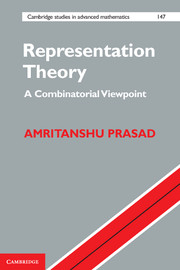Book contents
- Frontmatter
- Contents
- List of Tables
- Preface
- 1 Basic Concepts of Representation Theory
- 2 Permutation Representations
- 3 The RSK Correspondence
- 4 Character Twists
- 5 Symmetric Functions
- 6 Representations of General Linear Groups
- Hints and Solutions to Selected Exercises
- Suggestions for Further Reading
- References
- Index
2 - Permutation Representations
Published online by Cambridge University Press: 18 December 2014
- Frontmatter
- Contents
- List of Tables
- Preface
- 1 Basic Concepts of Representation Theory
- 2 Permutation Representations
- 3 The RSK Correspondence
- 4 Character Twists
- 5 Symmetric Functions
- 6 Representations of General Linear Groups
- Hints and Solutions to Selected Exercises
- Suggestions for Further Reading
- References
- Index
Summary
Group Actions and Permutation Representations
Definition 2.1.1 (G-set). Let G be a finite group. A G-set is a finite set X together with an action of G on X, namely a homomorphism a : G → Aut(X), where Aut(X) denotes the group of all bijections X → X. For convenience, we use the notation
g · x := a(g)(x).
We will use G-sets to construct interesting representations of G (see Definition 2.1.12).
Example 2.1.2 (Some G-set constructions). Let X and Y be G-sets. Then if we write g · (x, y) = (g · x, g · y), X × Y becomes a G-set. For a function f : X → Y, if we write (g · f)(x) = g · f(g−1x), then the set YX of all functions from X to Y becomes a G-set.
Definition 2.1.3 (Orbit). Let X be a G-set and x ∈ X. The G-orbit of x is the set
Gx := {g · x | g ∈ G}.
A subset O of X is said to be a G-orbit in X if it is the G-orbit of some point.
[1] Exercise 2.1.4. For two points x and y in a G-set X, write x ∼ y if y is in the G-orbit of x. Show that ‘∼’ is an equivalence relation. The equivalence classes are the G-orbits in X.
The set of G-orbits in X is usually denoted by G\X. Each G-orbit of X is a G-set in its own right.
Definition 2.1.5 (Transitive G-set). We say that a G-set X is transitive if X has only one G-orbit.
[1] Exercise 2.1.6. If X is a G-set and Y is an H-set, then X × Y is a G × H-set under the action (g, h) · (x, y) = (g · x, h · y). Describe the G × H-orbits in X × Y.
- Type
- Chapter
- Information
- Representation TheoryA Combinatorial Viewpoint, pp. 32 - 50Publisher: Cambridge University PressPrint publication year: 2015

